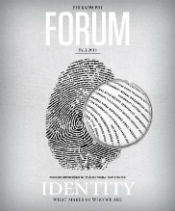
In This Section
Online Extras Fall 2018
The following online extras accompany the print version of the fall 2018 edition of the Forum, the theme of which is Identity.
"A Fight Over Identity: Native American Sports Mascots" by Kelly Young
Footnotes
- Mark Naymik, “Watch Indians Fans Go Off On Chief Wahoo Protesters,” Cleveland.com, April 11, 2017, https://www.cleveland.com/naymik/index.ssf/2017/04/watch_indians_fans_go_off_on_c.html.
- Sam Allard, “Why Chief Wahoo is Still Grinning: Protests Against the Cleveland Indians’ Racist, Red-Faced Caricature Never Work. They Just Make its Supporters Stronger,” Slate, Oct. 28, 2016, http://www.slate.com/articles/sports/sports_nut/2016/10/why_the_protests_against_chief_wahoo_never_work.html.
- King, Redskins 62.
- Casey Ryan Kelly, “Representations of Native Americans in the Mass Media,” Oxford Research Encyclopedia of Communication, 14 Jun. 2018, http://communication.oxfordre.com/view/10.1093/acrefore/9780190228613.001.0001/acrefore-9780190228613-e-142.
- C. Richard King & Charles Fruehling Springwood (eds.), “Introduction: Imagined Indians, Social Identities, and Activism,” in Team Spirits: The Native American Mascots Controversy, (Lincoln, NE: University of Nebraska Press, 2001), 3.
- C. Richard King, Redskins: Insult and Brand, (Lincoln, NE: University of Nebraska Press, 2016), 62.
- Kelly, 23-24.
- Erik Stegman and Victoria Phillips, “Missing the Point: The Real Impact of Native Mascots and Team Names on American Indian and Alaska Native Youth,” Center for American Progress, July 2014, https://cdn.americanprogress.org/wp-content/uploads/2014/07/StegmanAIANmascots-reportv2.pdf.
- Mary Landreth. “Becoming the Indians: Fashioning Arkansas State University’s Indians,” in Team Spirits: The Native American Mascots Controversy, eds. C. Richard King & Charles Fruehling Springwood (Lincoln, NE: University of Nebraska Press, 2001), 60.
- King and Springwood, 3. As Robert F. Berkhofter argues, these representations are Euro-American constructions that have little grounding in real Native American and indigenous identities. See The White Man’s Indian (New York: Vintage Books, 1979).
- Several excellent and recent books make this very argument. For example, see James V. Fenelon, Redskins? Sports, Mascots, Indian Nations, and White Racism (New York: Routledge, 2016) and King, Redskins.
- Eduardo Bonilla-Silva, Racism Without Racists, 4th ed. (Lantham, MD: Rowman & Littlefield, 2014), 1.
- John Nauright, “’A Besieged Tribe?’: Nostalgia, White Cultural Identity and the Role of Rugby in a Changing South Africa,” International Review for the Sociology of Sport 31, no. 1 (1996): 69.
- Paul J. Zingg, “Diamond in the Rough: Baseball and the Study of American Sports History,” The History Teacher 19, no. 3 (1986): 387-388.
- Warren Goldstein, Playing for Keeps: A History of Early Baseball, 20th Anniversary ed. (Ithaca, NY: Cornell University Press, 2009), 3.
- Carol Spindel, Dancing at Halftime: Sports and the Controversy over American Indian Mascots, (New York: New York University Press, 2002), 18-19.
- King, Redskins xiii.
Jackson B. Miller, “‘Indians,’ ‘Braves,’ and ‘Redskins’: A Performative Struggle for Control of an Image,” Quarterly Journal of Speech 85 (1999): 189.
